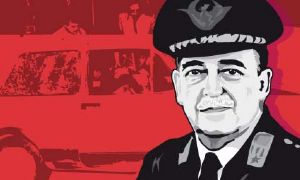On September 3, 1982, Carlo Alberto Dalla Chiesa and his 32-year-old bride of less than two months, Emanuela Setti Carraro, were gunned down with almost military precision by mob hitmen as they drove down via Carini in Palermo. Dalla Chiesa was a general in the carabinieri, the elite Italian police corps controlled by the Ministry of Defence, who had been sent as prefect to Sicily to fight the deeply entrenched mafia, which, with increasing violence continued to spread its tentacles far beyond the island’s shores. Dalla Chiesa’s police bodyguard, Domenico Russo, was also assassinated.
The brutality of these assassinations shocked even hardened underworld-watchers and jolted the Spadolini government into quickly enacting legislative measures that Dalla Chiesa had been calling for in vain. From the moment he arrived in Sicily, he had lamented that he felt isolated and without sufficient support from the state to do his job properly. It took his death for a new position of high commissioner against organized crime to be established and given sweeping investigative powers, including the right to tap the phones of suspected gangsters, examine bank records to look for money laundering activities and, in the hope of breaking the mafia’s code of silence, interrogate frightened or intimidated witnesses behind closed doors.

Hopes were high when Dalla Chiesa arrived in Palermo four months earlier. In the 1970s, he had become a national hero thanks to his success in the war against terrorism during the infamous anni di piombo (‘years of lead’), restoring faith in the nation’s institutions. Promoted general in 1973, he took over control of the northeastern area of Italy, including Piedmont, Valle d’Aosta and Liguria. In 1974, he created an antiterrorism squad in Turin made up of 10 top-notch officers whose job it was to break the back of the Brigate Rosse (BR), the extreme leftist terrorist organisation that inspired fear throughout the country with its campaign of political assassinations, kidnappings, kneecappings and robberies. This special squad succeeded, among other things, in capturing Renato Curcio and Alberto Franceschini, two of the top BR leaders. Earlier, in 1975, Dalla Chiesa had already been involved in an operation to free industrialist Vallarino Gancia, in which Curcio’s wife, Margherita Cagol, was killed.
In May 1977, Dalla Chiesa took over coordination of the security section of Italian prisons and instituted what became known as super-jails from which many terrorists and mafiosi soon learned that escape was almost impossible. To strengthen his anti-terrorism role, he was appointed coordinator of the police forces in September 1978 and given even greater powers after the BR kidnapped and assassinated Aldo Moro. With the help of undercover agents and ‘pentiti‘, those who repented and informed on fellow militants in return for lighter prison terms, Dalla Chiesa pieced together a picture of the terrorists’ organisational structure and arrested not only those who killed Moro but hundreds of other minor terrorist underlings.
However, unanswered questions remain about the Moro case, especially concerning the memoir the statesman wrote during the 55 days he was imprisoned by the BR. In its complete version, Moro is believed to have revealed secrets of state, discussed the fusion between politics and business, even dirty business, and described the occult financing of political parties. In October 1978, a typescript portion of this document was found by Dalla Chiesa’s squad in one of the terrorists’ lairs in via Montenevoso, in Milan (in 1990 a longer version came to light when the apartment was renovated). Voices at the time insinuated that there was more behind this memoir than met the eye. Thus, it was conjectured, although the mafia materially executed Dalla Chiesa, he may have been killed to conceal some hidden relationship between terrorism and the mafia or, more ominously, between the mafia and those among the then ruling political elite that Moro had exposed in his chronicle. One thing seems certain: papers in Dalla Chiesa’s possession relating to Moro mysteriously disappeared after his death.
Born in Saluzzo, near Cuneo on 27 September 1920, Dalla Chiesa fought in the infantry during World War II before fulfilling family tradition by joining the carabinieri, to which his father, Romano, and brother, Romolo, belonged. After the armistice, he joined the Resistance, taking part in the 1944 liberation of Rome together with the Allied troops. Once the war was over, armed with a degree in law, he was sent first to Campania and then to Sicily to combat brigandage, which was rife at the time. Typical of an army lifestyle, he spent brief periods serving in many different cities such as Florence, Como and Rome before once again returning to Sicily as colonel in command of the carabinieri of Palermo. Then, in 1973, he was promoted and sent to the north to combat the BR, consolidating his legend as a law enforcer.
Marking a career full of medals and decoration, this balding, bespectacled and austere man with a pencil moustache became second-in-command of the carabinieri in 1982. His officers, to whom he was extremely loyal, if authoritarian, proudly called themselves ‘Dalla Chiesa’s men.’ The public also loved it when he married his beautiful second wife, Emanuela, a Red Cross nurse from a prominent Milanese family, 30 years his junior. What made her killing all the more horrifying was the realisation that the ‘new’ mafia had abandoned its old so-called ‘code of honour’ of sparing women and children. No one was safe any more.
Today, two of the three children of Dalla Chiesa’s first marriage are well-known public figures. His son, Nando, a university professor, is active in politics and was recently an undersecretary in the second Prodi government, representing the Partito Democratico. His daughter, Rita, is a popular television personality.







